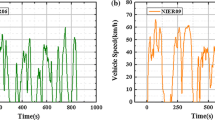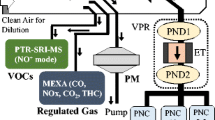Abstract
This paper mainly focused on the comparison of nanoparticle size distribution and number concentration level characteristics with gasoline and diesel fueled light duty vehicles. In the engine research, particle size distribution and number concentrations were analyzed by a DMS500 with engine parameters. Time-resolved particle number concentration levels from test vehicles were measured by a golden particle measurement system (GPMS) as recommended by a Particle Measurement Programme (PMP) on certification modes such as New European Driving Cycle (NEDC), Federal Test Procedure (FTP)-75, and Highway Fuel Economy Test (HWFET). In addition, particle emission characteristics from vehicles were analyzed by DMS500 during transient and high-speed driving conditions. From the results, we found that the formation of particles was highly dependent on vehicle speed and load conditions for each mode. The diesel vehicle equipped with a particulate filter showed substantial reduction of the total particle number whose number concentration was equivalent to that of the gasoline vehicle. The nucleation mode particles from gasoline fuel were mainly emitted; however, the accumulation mode particles from the diesel fuel were generally analyzed.
Similar content being viewed by others
References
D. Dockery, C. Pope and X. Wu, An association between air pollution and mortality in six US cities, New England Journal of Medicine, 329(24) (1993) 1753–1759.
B. Ostro, A research for a threshold in the relationship of air pollution to mortality: a reanalysis of London winters, Environmental Health Perspectives, 58 (1984) 397–399.
C. Pope, J. Schwartz and M. Ransom, Daily mortality and PM10 pollution in Utah Valley, Archives of Environmental Health, 47(3) (1992) 211–217.
K. Vaaraslahti, J. Keskinen, B. Giechaskiel, T. Murtonen and A. Solla, Effect of lubricant on the formation of heavy-duty diesel exhaust nanoparticles, Environmntal Science and Technology, 39 (2005) 8497–8504.
B. Giechaskiel, R. Munoz-Bueno, L. Rubino, U. Manfredi, P. Dilara and G. D. Santi, Particulate Measurement Programme (PMP): Particle size and number emissions before, during and after regeneration events of a Euro 4 DPF equipped light-duty diesel vehicle, SAE Paper No. 2007-01-1944 (2007).
J. R. Hagena, Z. S. Filipi and D. N. Assanis, Transient diesel emission, analysis of engine operation during a tip-In, SAE Paper No. 2006-01-1151 (2006).
M. Y. Kim and C. S. Lee, Effect of a narrow fuel spray angle and a dual injection configuration on the improvement of exhaust emissions in a HCCI diesel engine, Fuel, 86 (2007) 2871–2880.
C. W. Wu, R. H. Chen, J. Y. Pu and T. H. Lin, The influence of excess air ratio on engine performance and pollutant emission of an SI engine using ethanol-gasoline-blended fuels, Atmospheric Environment, 38 (2004) 7093–7100.
D. B. Kittelson, Engines and nanoparticles: A review, Journal of Aerosol Science, 29(5/6) (1998) 575–588.
B. Campbell, M. Peckham, J. Symonds, J. Parkinson and A. Finch, Transient gaseous and particulate emissions measurements on a diesel passenger car including a DPF regeneration event, SAE Paper No. 2006-01-1079 (2006).
D. Kayes and S. Hochgreb, Mechanism of Particulate Matter Formation in Spark-Ignition Engines, Environmental Science and Technology, 33 (1999) 3957–3967.
J. Andersson, B. Wedekind, D. Hall, R. Stradling and C. Barnes, DERT/SMMT/CONCAWE Particle Research Programme: Light-duty results, SAE Paper No, 2001-01-3577 (2001).
J. Andersson, D. Clarke and J. A. Watson, UK Particulate Measurement Programme (PMP): A near US 2007 approach to heavy duty diesel particulate measurements — comparison with the standard European method, SAE Paper No. 2004-01-1990 (2004).
J. Andersson, B. Giechaskiel, R. Munoz-Bueno, E. Sandbach and P. Dilara, Particle Measurement Programme (PMP) light-duty inter-laboratory correlation exercise (ILCE-LD) final report, JRC, EU (2007).
C. L. Myung, H. Lee, S. Kwon, S. Lee, J. Jun, Y. Lee, Y. Woo, M. Lee, G. N. Bae and S. Park, Interlaboratory correlation exercise on a light-duty diesel passenger vehicle to verify nano-particle emission characteristics by Korea particle measurement program, Journal of Mechanical Science and Technology, 23 (2009) 729–738.
J. W. Lee, Y. I. Jung, M. W. Jung, K. O. Cha, S. I. Kwon, J. C. Kim and S. Park, Experimental investigation and comparison of nano-particle emission characteristics in light-duty vehicles for two different fuels, International Journal of Automotive Technology, 9(4) (2008) 397–403.
C. Roberto, S. Volker, V. Rainer and B. Thorsten, Measurement of nucleation and soot mode particle emission from a diesel passenger car in real world and laboratory in situ dilution, Atmospheric Environment, 41 (2007) 2125–2135.
Bosch, Diesel engine management: An overview, Robert Bosch GmbH, Germany, (2003) 52–53.
G. B. Parvate-Patil, H. Hong and B. Gordon, An assessment of intake and exhaust philosophies for variable valve timing, SAE paper No. 2003-32-0078 (2003).
E. Wirojsakunchai, E. Schroeder, C. Kolodziej, D. E. Foster, N. Schmidt, T. Root, T. Kawai, T. Suga, T. Nevius and T. Kusaka, Detailed diesel exhaust particulate characterization and real-time DPF filtration efficiency measurements during PM filling process, SAE Paper No. 2007-01-0320 (2007).
W. C. Hinds, Aerosol technology 2 nd Edition, John Wiley & Sons, New York, (1999) 191–196.
TRANS-WP29-GRPE-48. Conclusions on Improving Particulate Mass Measurement Procedures and New Particle Number Measurement Procedures Relative to The Requirements of The 05 Series of Amendments to Regulation No. 83, http://www.unece.org/trans/doc/2004/wp29grpe.
Author information
Authors and Affiliations
Corresponding author
Additional information
This paper was recommended for publication in revised form by Associate Editor Kyoung Doug Min
Simsoo Park received his B.S. and M.S. degrees from Seoul National University in 1977 and 1979, respectively, and a Ph.D. from the State University of New York at Stony Brook. He served as a Chief Research Engineer at Hyundai Motor Company, a Director for Publication of the KSME, a Technical Advisor of Hyundai-Kia Motor Company, and an Editing Director, Project Director, International Director, Accounting Director, and General Affair Director of KSAE. He is currently Vice President and Editor-in-Chief of IJAT at KSAE and a professor in school of mechanical engineering at Korea University.
Hyungmin Lee received his B.S. degrees from Republic of Korea Naval Academy in 1997 and his M.S. degrees from Korea University in 2005, respectively. He served as an Operation Officer, Command Engineer Officer at various naval vessels. He is currently Ph.D. course in school of mechanical engineering at Korea University and his rank is a Lieutenant Commander of Korea Navy.
Rights and permissions
About this article
Cite this article
Lee, H., Kim, J., Myung, CL. et al. Experimental investigation of nanoparticle formation characteristics from advanced gasoline and diesel fueled light duty vehicles under different certification driving modes. J Mech Sci Technol 23, 1591–1601 (2009). https://doi.org/10.1007/s12206-009-0425-1
Received:
Revised:
Accepted:
Published:
Issue Date:
DOI: https://doi.org/10.1007/s12206-009-0425-1




